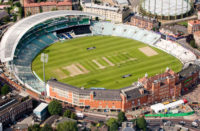Much of what we have today, from food to fashion to transportation and sport, is the result (but never a fait accompli), of years of transmutation and evolution. What we eat today differs greatly from what our grandparents laid out on their table and what King James I wore to ceremonies has (thankfully) nothing to do with what today’s presidents and prime ministers wear to assemblies. Sport, as any other man-made institution, was not spared this fate. You would be forgiven if, upon watching a rerun of a game from a hundred years ago, you fail to recognise which sport you’re actually watching. It’s not just the rules which change, but the players, the equipment, the pitch, the spectators… Anything which makes a game what it is today is a slow progression of, amongst others, technology, fitness and catering for the audience which will ultimately finance it all.
But let’s get to the core of what truly interests us here: cricket. The exact origin of the game is unknown but it is believed to have originated in South England and to have been a children’s game in the late 16th century, later taken up by adults. The first international game was played in 1844, quite some way back. Taking that date as a starting point (though we know it is nowhere near the first game ever played), cricket therefore had over 150 years to develop into what it is today. Our guess? We’ll only stop seeing changes once the game dies, and a game only dies when there’s nowhere there to see it being played. And aren’t we a long way off from that scenario?
Let’s see how cricket evolved over the years into the game we all love today.
- The Grounds
The stadiums we have today are quite a change from the woodlands where cricket was first played. Even in recent years, new technology has taken the grounds’ caretaking to new heights. It doesn’t matter when it was built (Have you ever been to Lord’s? It is spectacular – and built in 1814), they are immaculately well kept – thanks in part to better funding. Newer grounds can accommodate more spectators, while the improved outfields allow for better dives and slides.
- The Players
Much has changed on this front. Let’s start with the attire. Cricket was traditionally played in white but each team now has its own colours which it takes pride in. From painfully bright blues to greens to claret, they are quite a sight on the pitch. Players are also more physically fit. The demand on their strength and endurance is higher than before, necessitating rigorous training and discipline.
- The Money
It is obviously never just about the money but thanks to the rise in popularity of the sport and consequently a larger audience in attendance, more money has been pouring in. With so much going for it, bookies tapped onto the need for fans to wager on their favourite cricket teams, as the game allows for multiple wagering opportunities (and therefore, more money to be wagered on). This aspect has also helped with the steady growth in popularity of this sport. More money means there’s more at stake. Players play for the enjoyment of the game, but they also know there’s more to it than that, creating an edge to the game which was not there before.
- The Technology
The new viewing angles for cricket are pretty impressive. The drones, the spidercams – they help the viewer feel part of the game without necessarily being remotely close to it. The take in slow motion (though there’s nothing new there) still remains a favourite. The ever improved-upon snickometers bring precision like never before to the game, appeasing the Millennials in the pitch who would otherwise groan in frustration at how rudimentary things were.
- The Equipment
Let’s take a look at the bat and the ball. The ball has not changed much over the years (apart from the introduction of the second ball), but the bat has been through significant changes, to put it mildly. Today’s bat looks heavy (and in actual fact is) but feels much lighter. This is due to the fact that it is made of less compressed wood. Years ago, bats were made of a larger percentage of compressed wood to make them more durable but were also more difficult to wield. Today however, cricketers can go through 10 or 12 bats in a season, so making them durable is less of a priority. Batsmen are now more flexible in the way they take shots and run-rates have increased as a direct consequence.
- The Spectators
More and more people are watching cricket as whole nations, such as India, Pakistan, Australia, South Africa and the UK are driving ever more crowds to the stands. A billion viewers watched India vs Pakistan back in 2015, nine times the amount of the American Superbowl. We’ll let numbers speak for themselves.
Cricket is fast becoming the sport on everyone’s mouth. What began as an innocent child’s play has become a multi-million industry, with no signs of stopping. Every period has left a mark somewhere on the sport and though we look forward to seeing what other new changes the coming times will herald, we’re pretty sure the passion for the game will survive it all.













